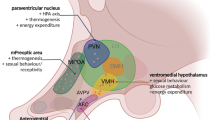Abstract
Cold restraint stress (CRS) induced vagal-dependent corpus mucosal erosions with hemorrhage in rats. Aggressive factors such as gastric acid, pepsin, and high-amplitude contractions have been reported to be responsible for inducing the formation of gastric lesions. Thyrotropin-releasing hormone (TRH) microinjected into the cisterna magna or the dorsal motor nucleus (DMN) of the vagus induced similar vagally mediated gastric injuries as CRS, and both were prevented by immunoneutralization with TRH antibody injected centrally. These findings indicated that TRH action in the DMN may contribute to CRS-induced gastric mucosal lesions. However, either exogenous or endogenous TRH at a subthreshold dose, which did not increase gastric acid secretion, alleviated gastric injury induced by intragastric administration of a strong irritant in rats. Previous studies have shown that the vagus participates in adaptive cytoprotection. Vagotomy or intracisternal injection of TRH-antibody completely abolished the protective effect of a mild irritant pretreatment in rats. The number of c-Fos protein-positive cells in the DMN increased in the process of adaptive cytoprotection. These results suggest that vagal afferent nerves activated by a topical gastric irritant influence DMN activity by releasing endogenous TRH, leading to protection against injury induced by a subsequent strong irritant. The dual vagally mediated action of TRH in the medulla to regulate the gastric mucosa’s response to injury reflects the balance between the aggressive (acid, pepsin, motility) and protective (prostaglandin, calcitonin gene-related peptide, nitric oxide) factors recruited by the level of vagal activation. These data indicate a crucial role of medullary TRH and gastric vagal efferent and afferent circuits in the modulation of gastric integrity.
Similar content being viewed by others
References
Lynn RB, Kreider MS, Miselis RR. Thyrotropin-releasing hormone-immunoreactive projections to the dorsal motor nucleus and the nucleus of the solitary tract of the rat. J Comp Neurol 1991;311:271–88.
Taché Y, Yoneda M. Central action of TRH to induce vagally mediated gastric cytoprotection and ulcer formation in rats. J Clin Gastroenterol 1993;17 Suppl l:S58–63.
Garrick T, Prince M, Yang H, Ohning G, Taché Y. Raphe pallidus stimulation increases gastric contractility via TRH projections to the dorsal vagal complex in rats. Brain Res 1994;636:343–7.
Yang H, Ohning G, Taché Y. TRH in dorsal vagal complex mediates acid response to excitation of raphe pallidus neurons in rats. Am J Physiol 1993;265:G880–6.
Basso N, Bagarani M, Pekary E, Genco A, Materia A. Role of thyrotropin-releasing hormone in stress ulcer formation in the rat. Dig Dis Sei 1988;33:819–23.
Yang H, Wu SV, Ishikawa T, Taché Y. Cold exposure elevates thyrotropin-releasing hormone gene expression in medullary raphe nuclei: relationship with vagally mediated gastric erosions. Neuroscience 1994;61:655–63.
Yang H, Yuan P-Q, Wang L, Tach/’e Y. Activation of the parapyramidal region in the ventral medulla stimulates gastric acid secretion through vagal pathways in rats. Neuroscience 2000;95:773–9.
Miampamba M, Yang H, Sharkey KA, Taché Y. Intracisternal TRH analog induces Fos expression in gastric myenteric neurons and glia in conscious rats. Am J Physiol 2001;280:G979–91.
Yuan P-Q, Tach/’e Y, Miampamba M, Yang H. Acute cold exposure induces vagally mediated Fos expression in gastric myenteric neurons in conscious rats. Am J Physiol 2001;281:G560–8.
Kaneko H, Taché Y. TRH in the dorsal motor nucleus of vagus is involved in gastric erosion induced by excitation of raphe pallidus in rats. Brain Res 1995;699:97–102.
Taché Y, Yoneda M, Kato K, Kiraly Á, Sütó G, Kaneko H. Intracisternal thyrotropin-releasing hormone-induced vagally mediated gastric protection against ethanol lesions: central and peripheral mechanisms. J Gastroenterol Hepatol 1994;9:S29–35.
Kaneko H, Yang H, Ohning G, Taché Y. Medullary TRH is involved in gastric protection induced by a low dose of kainic acid into the raphe pallidus. Am J Physiol 1995;268:G548–52.
Kaneko H, Kaunitz J, Taché Y. Vagal mechanisms underlying gastric protection induced by chemical activation of the raphe pallidus in rats. Am J Physiol 1998;275:G1056–62.
Kaneko H, Kato K, Ohning G, Taché Y. Medullary thyrotropinreleasing hormone mediates vagal-dependent adaptive gastric protection induced by mild acid in rats. Gastroenterology 1995;109:861–5.
Kaneko H, Wang L, Kato K, Taché Y. Role of medullary thyrotropin-releasing hormone (TRH) in vagally mediated adaptive cytoprotection in rats. Gastroenterology 1995;108:A980.
Tally NJ, Stanghellini V, Heading RC, Koch KL, Malagelada JR, Tytgat GN. Functional gastroduodenal disorders. Gut 1999;45 Suppl 11:1134–42. /
Schuligoi R, Jocic M, Heinemann A, Schoninkle E, Pabst MA, Holzer P. Gastric acid-evoked c-fos messenger RNA expression in rat brainstem is signaled by capsaicin-resistant vagal afferents. Gastroenterology 1998;115:649–60.
Author information
Authors and Affiliations
Rights and permissions
About this article
Cite this article
Kaneko, H., Taché, Y. & Kusugami, K. Importance of medullary thyrotropin-releasing hormone in brain-gut circuits regulating gastric integrity: preclinical studies. J Gastroenterol 37 (Suppl 14), 128–132 (2002). https://doi.org/10.1007/BF03326431
Published:
Issue Date:
DOI: https://doi.org/10.1007/BF03326431




